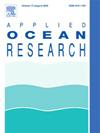LiDAR target detection and classification for ship situational awareness: A hybrid learning approach
IF 4.3
2区 工程技术
Q1 ENGINEERING, OCEAN
引用次数: 0
Abstract
In recent years, LiDARs have been used to enhance situational awareness of autonomous vehicles, including in the marine domain, driven by the need for reliable detections in Marine Autonomous Surface Ships and Unmanned Surface Vehicles. Detecting obstacles and targets within point clouds is generally handled by a fully unsupervised learning framework. While effective and simple, this approach cannot classify targets. This paper presents a combined unsupervised/supervised approach for detecting and classifying marine targets and obstacles. The unsupervised detection framework is maintained by incorporating a lightweight supervised module capable of classifying detection outputs without disrupting the workflow. Rather than training on the entire point cloud, the proposed method focuses on selected target features, reducing model size and information exchange. Specifically, a Random Forest Classifier is trained on features extracted from the point-cloud dataset. The acquisition of an ad-hoc training dataset and its statistical analysis are presented to identify key features. The selection, training, and validation processes are outlined. Finally, the supervised model is integrated into a state-of-the-art unsupervised LiDAR detection pipeline and tested in a real scenario. The results demonstrate the hybrid framework’s effectiveness and compliance with real-time constraints.
舰船态势感知激光雷达目标探测与分类:一种混合学习方法
近年来,由于海洋自主水面舰艇和无人水面车辆需要可靠的检测,激光雷达已被用于增强自动驾驶车辆的态势感知,包括在海洋领域。检测点云中的障碍物和目标通常由完全无监督的学习框架处理。这种方法虽然简单有效,但不能对目标进行分类。提出了一种无监督/有监督相结合的海洋目标和障碍物检测与分类方法。无监督检测框架是通过合并一个轻量级的监督模块来维护的,该模块能够在不中断工作流程的情况下对检测输出进行分类。该方法不是在整个点云上进行训练,而是专注于选定的目标特征,减少了模型尺寸和信息交换。具体来说,随机森林分类器是根据从点云数据集中提取的特征进行训练的。本文介绍了一个特别训练数据集的获取及其统计分析,以识别关键特征。概述了选择、培训和验证过程。最后,将监督模型集成到最先进的无监督LiDAR检测管道中,并在真实场景中进行测试。结果表明,该混合框架具有良好的实时性和有效性。
本文章由计算机程序翻译,如有差异,请以英文原文为准。
求助全文
约1分钟内获得全文
求助全文
来源期刊

Applied Ocean Research
地学-工程:大洋
CiteScore
8.70
自引率
7.00%
发文量
316
审稿时长
59 days
期刊介绍:
The aim of Applied Ocean Research is to encourage the submission of papers that advance the state of knowledge in a range of topics relevant to ocean engineering.
 求助内容:
求助内容: 应助结果提醒方式:
应助结果提醒方式:


